| Home | First Posted May 11, 2009 Jan 21, 2020 | |
Horses in ArtHorses have appeared in works of art throughout history, frequently as depictions of the horse in battle. The horse appears less frequently in modern art partly because the horse is no longer significant either as a mode of transportation or as an implement of war. Most modern representations are of famous contemporary horses, art work associated with horse racing, or art work associated with the historic cowboy or Native American tradition of the American west. In the United Kingdom depictions of fox hunting and nostalgic rural scenes involving horses continue to be made. Horses often appear in art work singly, as a mount for an important person, or in teams, hitched to a variety of horse-drawn vehicles. History of the Horse in Art
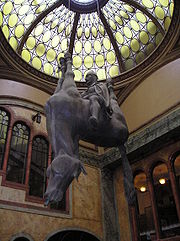 The "Dead Horse" is a sculpture from Czech sculptor David Cerný. It is a parody of the statue of St. Wenceslas on Wenceslas square some 200 meters away. It can be found in the passage Lucerna Kavarna.
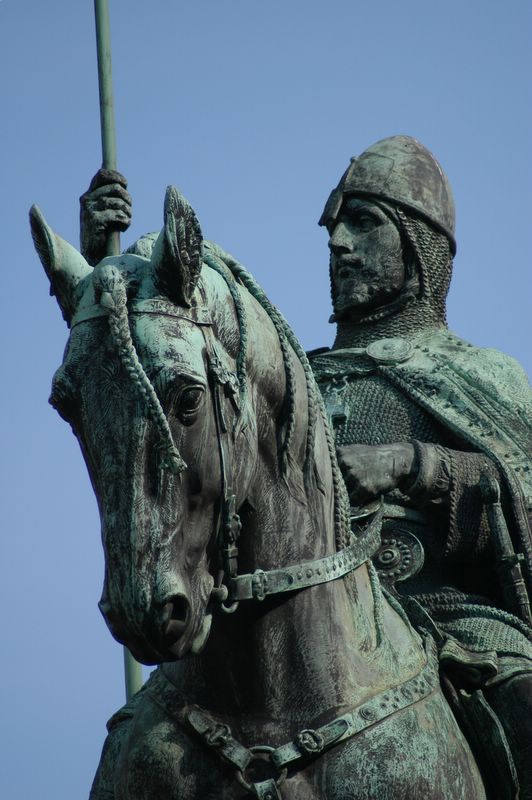 Statue of St. Wenceslas
Probably the best known Prague statue, and also a very popular meeting place of Prague citizens is the St. Wenceslas Monument in the upper part of the Wenceslas Square. It represents the patron of the country, St. Wenceslas, the Duke of Bohemia in the 10th century. This monument saw many important events of Czech history, including the establishment of the independent republic Czechoslovakia in 1918. St. Wenceslas Monument consists of the 5.5 metres high statue of St. Wenceslas and statues of other Czech patrons around him: St. Ludmila on the left, St. Agnes behind her, St. Procopius on the right and St. Adalbert behind him. The monument was made between 1887 and 1924 by Josef Vaclav Myslbek.
Prague Lucerna passage
Prague Lucerna passage -- The horse appeared in prehistoric cave paintings such as those in the Lascaux caves, estimated to be 16,000 years old. Prehistoric hill figures have been carved in the shape of the horse.
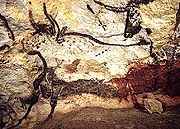 Cave Paintings of the horse at Lascaux, France
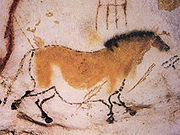 Horse Cave Paintings at Luscaux, France
The equine image was common in ancient Egyptian and Grecian art, more refined images displaying greater knowledge of equine anatomy appeared in Classical Greece and in later Roman work. Horse drawn chariots were commonly depicted in ancient works, for example on the Standard of Ur circa 2500 BC. The Horses of Saint Mark are the sole surviving example from Classical Antiquity of a monumental statue of the Quadriga.
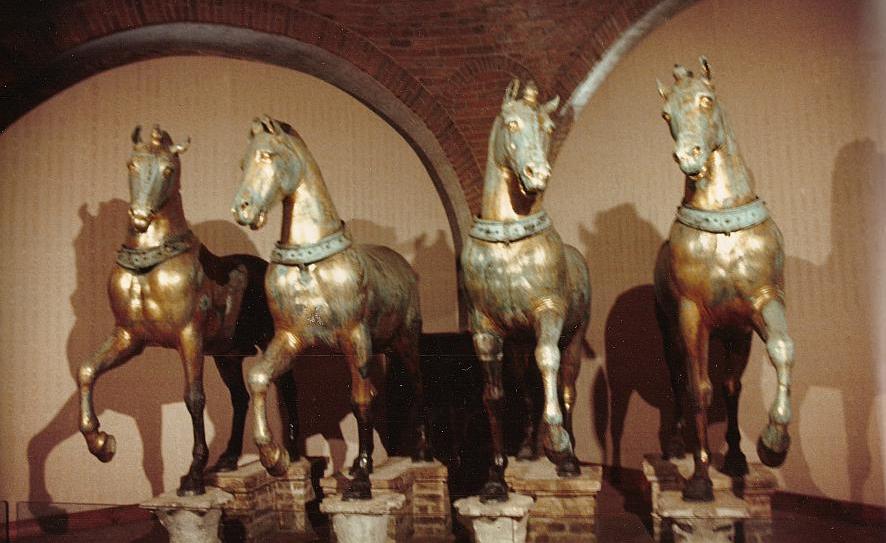 Horses of St. Mark/Copyright HorseHints.org
The horse was less prevalent in early Christian and Byzantine art, overwhelmed by the dominance of religious themes. The Renaissance period starting in the 14th century brought a resurgence of the horse in art. Painters of this period who portrayed the horse included Paolo Uccello, Benozzo Gozzoli, Leonardo da Vinci, Albrecht Dürer, Raphael, Andrea Mantegna and Titian.
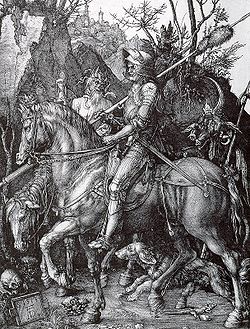 "Knight, Death and the Devil" by Albrecht Dürer
 Paolo Uccello, St. George and the Dragon/1456
In the Baroque era the tradition of equine portraiture was established, with artists such as Peter Paul Rubens, Anthony van Dyck and Diego Velázquez portraying regal subjects atop their mounts. Equine sporting art also became established in this era as the tradition of horse racing emerged under Tudor patronage. The mid 18th century saw the emergence of Romanticism, French artists Théodore Gáricault and Eugène Delacroix were proponents of this movement and both portrayed the horse in many of their works. George Stubbs born in 1724 became so associated with his equestrian subjects that he was known as "the horse painter". A childhood interest in anatomy was applied to the horse he spent eighteen months dissecting equine carcasses and had an engraver produce book plates of his studies. These anatomical drawings aided later artists. Equine sporting art was popular in the 19th century, notable artists of the period being Benjamin Marshall, James Ward, Henry Thomas Alken, James Pollard and John Frederick Herring, Sr.. Horse racing gradually became more established in France and Impressionist painter Edgar Degas painted many early racing scenes. Degas was one of the first horse painters to use photographic references. Eadweard Muybridge's photographic studies of animal motion had a huge influence on equine art as they allowed artists greater understanding of the horses gaits. Sir Alfred Munnings was an acclaimed painter working in England during the 20th century, he was elected president of the Royal Academy in 1944. He specialized in equine subjects, including horse racing, portraiture and studies of gypsies and rural life.
Subject Genres
Military and War Military art often depicts the horse in battle and provides some of the earliest examples of the horse in art, with cavalry, horse drawn chariots and horse archers all appearing on ancient artifects. "Knight, Death and the Devil" by Albrecht Dürer - In the medieval period cavalry battles and knights on horseback were portrayed by artists including Paolo Uccello and Albrecht Dürer. Uccello's tryptic, The Battle of San Romano, shows various stages of a battle. Dürer's engraving of "Knight, Death and the Devil", 1513 shows a military subject combined with allegorical theme. Sir Alfred Munnings was appointed as a war artist during World War I, he painted both the Canadian Cavalry Brigade and the Canadian Forestry Corps stationed in France. He considered his experiences with the Canadian units to have been among the most rewarding events of his life. Elizabeth Thompson, known as Lady Butler, was famed for her military art, especially "Scotland Forever" featuring a dramatic charge by the Royal Scots Greys.
 For a large and complex 20th century war painting in which a horse is the central dramatic figure, see Guernica by Pablo Picasso. Horse Racing Thoroughbred racing was an inspiration for Romantic and Impressionist artists of the 19th century. Theodore Gericault painted the Epsom Derby in 1821 during his stay in England. The Impressionist era coincided with the development of racing in France, Manet, Degas and Toulouse-Lautrec all acquired a lasting fascination with racing. Manet showing the excitement and action of the race and Degas concentrating more on the moments before the start. Degas was intensely interested in Muybridge's photographs of the horse in motion, he copied them in chalk and pencil and used them for reference in his later work. Generations of artists before Muybridge had portrayed the horse in a 'rocking horse' gallop with the horse portrayed with both front legs extended forward and both hind legs extended rearwards. Much more realistic representations were possible after the event of photography and Muybridge's work but that did not necessarily lead to the impression of movement in the art work. Luard writing in 1921 compares the running action of an animal with the run and rhythm of an air in music, but the instantaneous moment recorded by a photograph as a detached chord with little meaning or context. George Stubbs and Alfred Munnings have both left a vast body of work involving the racehorse. In the 20th century, much of the art work by John Skeaping involved the racing scene, including life size bronzes of Hyperion and Brigadier Gerard and watercolours of race course action. Hunting Hunting scenes have been a common subject matter for equestrian painters, specialists in fox hunting subjects include Cecil Aldin and Lionel Edwards. Rural/Working Life Lucy Kemp-Welch was well known for her depiction of wild and working horses in the landscape. The American West Art work associated with the historic cowboy or Native American tradition of the American west naturally includes many equine subjects. Artists of the American West include Frederick Remington and C.M. Russell who are known for their paintings of equine subjects. Remington was one of the first American artists to illustrate the true gait of the horse in motion (along with Thomas Eakins), as validated by the famous sequential photographs of Eadweard Muybridge. Remington also captured equine drama in his bronze sculptures, his first, Bronco Buster (Williams College Museum of Art), was a critical and commercial success. Horse Statues in Washington, DC |